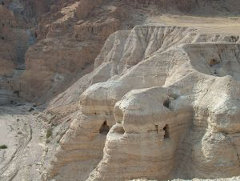The Men of Qumran: Description and Controversy of the Scrolls

Description of the Scrolls
As soon as the announcement of the scrolls’ discovery was made, the scholarly debates about their origin and significance began. The debates increased when the amazing contents of the scrolls were successively revealed.
The seven original scrolls, from what came to be called “Cave One,” comprised the following: (1) a well preserved copy of the entire prophecy of Isaiah—the oldest copy of an Old Testament book ever to be discovered; (2) another fragmentary scroll of Isaiah; (3) a commentary on the first two chapters of Habakkuk—the commentator explained the book allegorically in terms of the Qumran brotherhood; (4) the “Manual of Discipline” or “Community Rule”—the most important source of information about the religious sect at Qumran. It described in detail the requirements for those aspiring to join the brotherhood and how they were to behave and worship; (5) the “Thanksgiving Hymns,” a collection of devotional “psalms” of thanksgiving and praise to God; (6) an Aramaic paraphrase of the Book of Genesis; and (7) the “Rule of War” which dealt with the battle between the “Sons of Light” (the men of Qumran ) and the “Sons of Darkness” (the Romans?) yet to take place in the “last days,” which days the men of Qumran believed were about to arrive.

Discussion